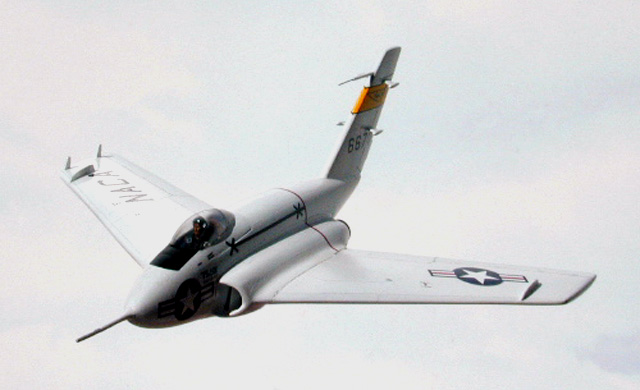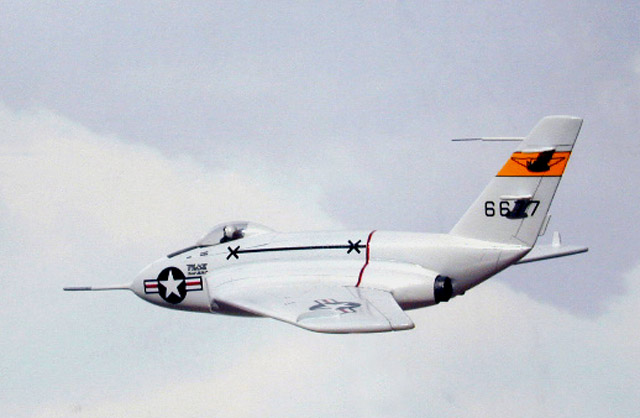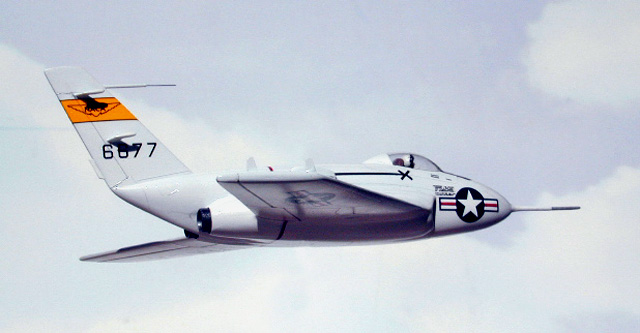



Model Subject: Northrup X-4 "Bantam"
Kit used: MPM, kit number 72093
History of the aircraft modeled:
The Northrop X-4, Bantam, was a single-place, swept-wing, semi-tailless airplane designed and built to investigate that configuration at transonic speeds (defined as speeds just below and just above the speed of sound, but in this case, the testing was done primarily at just below the speed of sound). The hope of some aerodynamicists was that eliminating the horizontal tail would also do away with stability problems at transonic speeds resulting from the interaction of supersonic shock waves from the wings and the horizontal stabilizers.
Northrop Aircraft, Inc. built two X-4 aircraft, the first of which proved to be mechanically unsound. However, ship number 2, with a thicker trailing edge on the wings and elevon, was very reliable. Ship 1 was then grounded and used as parts for ship 2. While being tested from 1950 to 1953 at the NACA High-Speed Flight Research Station (predecessor of today's NASA Dryden Flight Research Center, Edwards, California), the X-4's semi-tailless configuration exhibited inherent longitudinal stability problems (porpoising) as it approached the speed of sound.
The X-4 was a small twinjet-engine airplane that had no horizontal tail surfaces, depending instead on combined elevator and aileron control surfaces (called elevons) for control in pitch and roll attitudes. Data gathered from the aircraft's blunt elevon research were helpful in the design of the Bell X-2, which had ailerons with blunted trailing edges. The NACA X-4 program also provided substantial data on the interactions of combined pitching, rolling, and yawing motions. This interaction was soon to become critical to upcoming high-performance military fighters. The X-4, ship 2, flew 82 research flights from 1950 to 1953. With a minimal lift-to-drag ratio of less than 3, the X-4 performance was similar to the soon-to-be-developed X-15. With this similarity in mind, NACA conducted approach and landing studies of X-15-generation aircraft using the X-4. The X-4, retired in 1954, ended its days as a pilot trainer.
Building the model:
Cockpit:
Build using the kit parts except the headrest, which was too wide for the canopy
to close correctly, even my scratch-built replacement tilts too far forward,
but that's the way it had to be for the canopy to close properly. The pilot
is a PJ Production 1.72 scale resin figure. He was primed in neutral gray and
hand painted. Ink and acrylic washes were used. Harnesses buckles are cut from
a True Details 1/72 photoetch seat belts and super glued to harnesses made from
sanded masking tape strips painted olive.
The cockpit was painted Light Ghost Gray and the instrument panel black. Instrument gauges were done with Reheat Models instrument panel decals applied over white punched disks of white trim. The headrest was painted leather. Reheat Models control placard and data placard decals were used also on the side panels made from cut sheet styrene. A scratch-built throttle was also added from a cut piece of a punched disk and some fine wire.
Intakes:
The basically were none. I took a cheap shot and ran some pseudo intake fans
and sidewall from gloss white photo print sheet. It was easy, but it ain't all
that correct. It still looks better than the kit's see through intakes.
Exhausts:
I didn't like the tiny little exhausts, so I made my own from Styrene tube.
I also made a backing from pseudo exhaust prints. The exhausts were painted
back followed by Gunze Burnt Iron. They were installed in the final assembly.
Exterior:
Okay, this was the usual sand and fit PMP kit. It is not up to standards of
the industry, but once you get there, you will have an attractive little model.
But far an away, the hardest part of this kit was getting those tine tail balances
glue on and lined up. They were part of the resin parts, which also included
the wing fence and nose pitot. The canopy was masked with Bare-metal foil and
the entire model primed in Polly Scale Reefer White. After a little fix up,
I sprayed two more coats of reefer white and let dry. I used two coat of MM
Gloss Clear Acryl for decal prep.
Decals from the kit were used and they were excellent. They moved
a little better than former Propagtem decals, but beware, they are exceedingly
thin and will fold under as the slightest breath. I only managed to muck up
one of the fuel filler decals and simply left two off. But the others were very
good, not problems at all.
After the decals had dried, I gave the model two coats of Future. It got a little
thick on the upper starboard wing and some touch up can be seen, ah shucks.
The model was given two more coats of Future to help hide the touch up a bit,
but you can still see it. I replaced the vertical tail pitot with hypo tubing
and fine wire.
Article and photos © Caz Dalton, October 2001